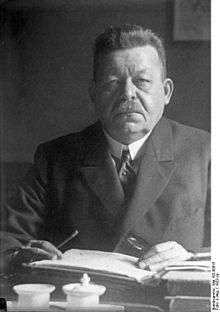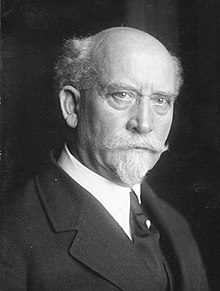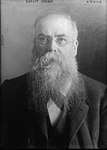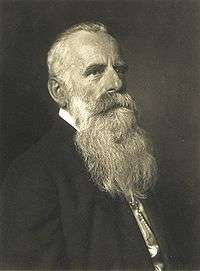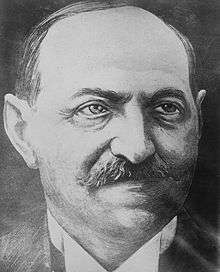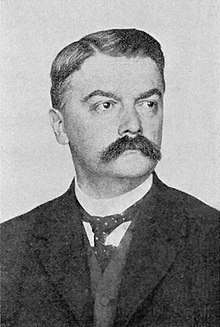1919 German federal election
Federal elections were held in Germany on 19 January 1919,[1] although members of the standing army in the east did not vote until 2 February. The elections were the first of the new Weimar Republic, which had been established after World War I and the Revolution of 1918–19, and the first with women's suffrage. The previous constituencies, which heavily overrepresented rural areas, were scrapped, and the elections held using proportional representation.[2] The voting age was also lowered from 25 to 20.[3] Austrian citizens living in Germany were allowed to vote, with German citizens living in Austria being allowed to vote in the February 1919 Constitutional Assembly elections.[4]
| |||||||||||||||||||||||||||||||||||||||||||||||||||||||||||||
All 423 seats in the Weimar National Assembly 212 seats needed for a majority | |||||||||||||||||||||||||||||||||||||||||||||||||||||||||||||
|---|---|---|---|---|---|---|---|---|---|---|---|---|---|---|---|---|---|---|---|---|---|---|---|---|---|---|---|---|---|---|---|---|---|---|---|---|---|---|---|---|---|---|---|---|---|---|---|---|---|---|---|---|---|---|---|---|---|---|---|---|---|
| Registered | 37,375,488 | ||||||||||||||||||||||||||||||||||||||||||||||||||||||||||||
| Turnout | 30,538,236 (83.0%) | ||||||||||||||||||||||||||||||||||||||||||||||||||||||||||||
| |||||||||||||||||||||||||||||||||||||||||||||||||||||||||||||
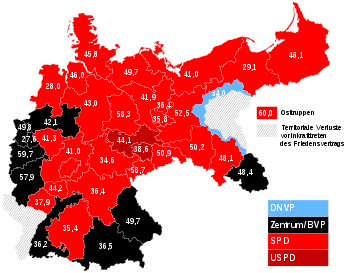 Electoral results by districts Hatched: Occupied territory (Alsace-Lorraine, Posen) pending Treaty of Versailles. | |||||||||||||||||||||||||||||||||||||||||||||||||||||||||||||
| |||||||||||||||||||||||||||||||||||||||||||||||||||||||||||||
From its inaugural session on 6 February, the National Assembly (Nationalversammlung) functioned as both a constituent assembly and unicameral legislature. The supporting parties of the "Weimar Coalition" (SPD, Zentrum and DDP) together won 76.2% of the votes cast, and on 13 February, provisional president Friedrich Ebert appointed Philipp Scheidemann of the SPD as Minister-President. The office was later renamed Chancellor when the Weimar Constitution came into force in August 1919. The Scheidemann cabinet replaced the revolutionary Rat der Volksbeauftragten (Council of the People's Deputies). Voter turnout was 83.0%.[5]
Results
 | ||||
|---|---|---|---|---|
| Party | Votes | % | Seats | |
| Election of 19 January 1919 | ||||
| Social Democratic Party | 11,509,048 | 37.86 | 163 | |
| Centre Party | 5,980,216 | 19.67 | 91 | |
| German Democratic Party | 5,641,825 | 18.56 | 75 | |
| German National People's Party | 3,121,479 | 10.27 | 44 | |
| Independent Social Democratic Party | 2,317,290 | 7.62 | 22 | |
| German People's Party | 1,345,638 | 4.43 | 19 | |
| Bavarian Peasants' League | 275,125 | 0.91 | 4 | |
| German-Hanoverian Party | 77,226 | 0.25 | 1 | |
| Schleswig-Holstein Farmers and Farmworkers Democracy | 57,913 | 0.19 | 1 | |
| Braunschweig State Electoral Association | 56,858 | 0.19 | 1 | |
| Mecklenburg Village League | 10,891 | 0.04 | 0 | |
| German Peace Party | 3,503 | 0.01 | 0 | |
| German Officials', Employees' and Middle Class Party | 1,438 | 0.00 | 0 | |
| Christian Social Party | 664 | 0.00 | 0 | |
| Middle Class Party | 640 | 0.00 | 0 | |
| German Social Aristocracy | 279 | 0.00 | 0 | |
| Democratic Middle Class Party | 208 | 0.00 | 0 | |
| Social Reform Party | 45 | 0.00 | 0 | |
| Invalid/blank votes | 124,562 | – | – | |
| Total | 30,524,848 | 100 | 421 | |
| Registered voters/turnout | 37,362,100 | 83.02 | – | |
| Election of 2 February 1919 – representatives of standing troops in the East | ||||
| Social Democratic Party | 7,804 | 60.04 | 2 | |
| Independent Social Democratic Party of Germany | 1,945 | 14.96 | 0 | |
| German Democratic Party | 1,681 | 12.93 | 0 | |
| Non-partisan lists | 1,389 | 10.69 | 0 | |
| German People's Party | 74 | 0.57 | 0 | |
| German National People's Party | 62 | 0.48 | 0 | |
| Centre Party | 43 | 0.33 | 0 | |
| Invalid/blank votes | 390 | – | – | |
| Total | 13,388 | 100 | 2 | |
| Source: Nohlen & Stöver, Gonschior.de | ||||
References
- Dieter Nohlen & Philip Stöver (2010) Elections in Europe: A data handbook, p762 ISBN 978-3-8329-5609-7
- Nohlen & Stöver, p747
- Nohlen & Stöver, pp746–748
- Austria votes today. – German Part of Former Dual Monarchy Chooses Its Constituent Assembly., The New York Times, 16 February 1919 (PDF)
- Nohlen & Stöver, p776
